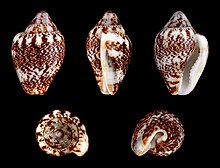Manerba del Garda necropolis
Between 1976 and 1994 the Neolithic necropolis of Manerba del Garda , on the western shore of Lake Garda, was excavated. The chambers of the collective burials were made of wood, which is also the case in the rest of the megalithic area . B. in East England is not uncommon. Apart from the megalithic sites at Saint Martin de Corléans , just outside Aosta , the Manerba sites are the best-known sites of this type in northern Italy . The practice of collective burial under abrises and in caves is linked to the “Civate Group” on the southern edge of the Alps. Burials and statue menhirs can be found on the axis between Lake Garda and the Adige Valley .
location
The necropolis lies below the rocks of Monte Sasso , a rock overhang on the so-called "Riparo Valtenesi". The archaeological layers have been damaged by limestone mining since the Roman period , but eight grave complexes have been examined. The Roman workers avoided disrupting the burials and left them as islands. The graves were indicated by gravel floors about 2.0 x 1.0 m. Traces of the wooden chambers were found at three of the facilities.
The northern chambers
A group of graves (MS 132-135), known as the “northern chambers”, provides an overview of the activities. The surface of the rock was leveled before they were laid. Ritual acts were associated with some campfire sites and two large posts that may have been wooden statues similar to those in Aosta.
The grave goods were of interest , including ceramics, arrowheads and stone axes , but above all white calcite and black soapstone pearls , as well as colorful shells of the sea snail Columbella rustica . In total, more than 2000 pieces were found, all of which appear to have been laid down as pearl necklaces - sometimes after the decarnation . Copper was present in the form of small awls and pearls. The pearls found at each burial belong to 17 individual chains. In one case, a charred cord was found which turned out to be animal fiber. The animal bones found come from dogs or wolves, the teeth from pigs.
Many graves appear to have been set on fire on purpose. They collapsed and the platform was covered in rubble. Several fire utensils were found on the premises, two were in the burned-down chambers. The platforms were covered by flat piles of stones, which internally had rows of boulders that had structural or symbolic significance, as they, in addition to the wooden structure, enclosed the burials, so that their contents, in three cases since the 3rd millennium BC. Chr. Remained undisturbed.
Large quantities of fruit, grain and seeds were burned on the platforms and deposited in layers all around. A small fireplace was found where many plants were burned. Burned fruit was in chamber 133 and in a stone box with a children's burial.
Some graves were destroyed, others burned. Some were missing the skull, others were not. The diversity of practice was also noted elsewhere. For example, the southern chambers were completely different from the others. Here, under the floor of the chamber, was a double pit with dismembered and broken bones of a single person that were decarnated.
Even today, the Sasso has an iconic meaning for the region, which is expressed in its use in the city arms. A similar combination of niches, abrises and rock walls of the so-called Civate group was found in the nearby “Monte Covolo”.
context
Despite the local ideology, the burial ritual shows a remarkable resemblance to that in wooden chambers made of long and round mounds in Great Britain and elsewhere in Northern Europe, which were built nearly a thousand years before the Manerba necropolis.
Other archaeological finds from the Abri are also of interest. In a small settlement area that can be dated to the transition from the Middle to the Neolithic, ceramics of the early Neolithic VHO culture were discovered together with relics of the flint industry of the late Middle Stone Age Castelnovian culture. The finds are in the Archaeological Museum of Valtenesi.
literature
- Lawrence H. Barfield: Excavations in the Riparo Valtenesi, Minerba, 1976-1994. Florence 2007, ISBN 978-88-6045-052-4 .
Individual evidence
- ↑ The Riparo Valtenesi is a natural terrace at the foot of the rock face of Monte Sasso with a length of about 60 m and a depth of 90 m, which lies directly on the lake.
- ↑ In addition to a rod-shaped flint and a pyrite bulb , the fire cutlery usually included an easily flammable tinder sponge .
Web links
- Description Engl.
- Find report, site plans
- Lawrence H. Barfield: Copper Age Pottery from the Riparo Valtenesi, Manerba del Garda. on: laboratoriobagolini.it
Coordinates: 45 ° 33 ′ 21 ″ N , 10 ° 34 ′ 41 ″ E

